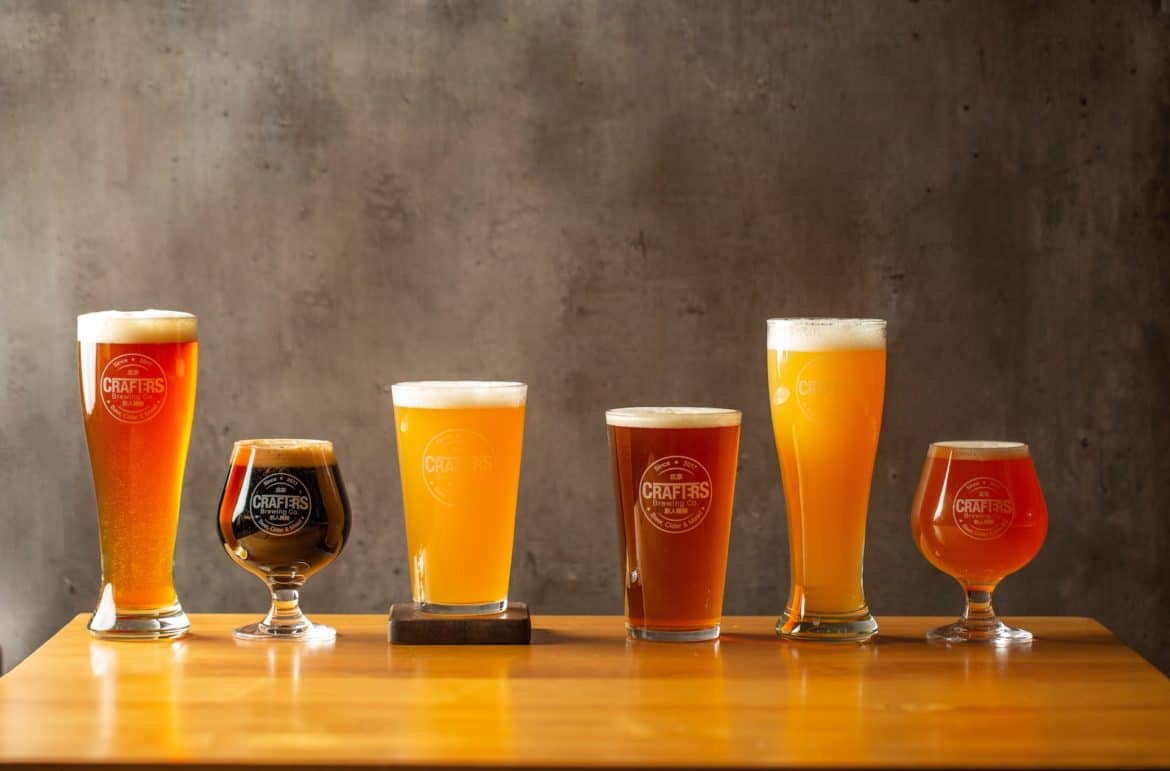Welcome, beer aficionados, to an enchanting journey into the world of beer tasting. In this blog post, we’ll uncover the spellbinding universe that transforms beer tasting into a true haven for enthusiasts!
We will strive to cover the basics for those who are starting to show interest in the subject and want to delve a little deeper into this delight that originated in ancient Egypt. Beer has become a powerful icon that brings along stories and cultural characteristics in addition to being a great option during hot summers. This article will equip you with valuable insights and tips to enhance your beer tasting experience. So grab your favorite brew, sit back, and let’s embark on this enlightening adventure together.
The Very Basics of Beer Tasting: The Tasting Process

Beer tasting is an art that engages multiple senses and requires a mindful approach. To truly appreciate the nuances of each brew, it’s essential to understand the basics of beer tasting.
Begin by pouring your beer into a clean, appropriate glass, allowing it to settle and release its aromas. Take a moment to observe the beer’s appearance—its color, clarity, and effervescence. These visual cues can offer valuable hints about the style and quality of the beer.
Now, bring the glass to your nose and inhale deeply, savoring the aromas that waft towards you. The aromatics of a beer can range from fruity and floral to malty and earthy, providing insight into the ingredients and brewing process. Take note of any distinct scents that catch your attention, as they will contribute to your overall tasting experience.
Next comes the moment we’ve been waiting for—tasting the beer. Take a small sip and let it coat your entire palate. Pay attention to the flavors that unfold on your mouth. Is it bitter or sweet? Are there hints of caramel, citrus, or spices? Each beer has its unique flavor profile, and exploring these intricacies is what makes beer tasting so fascinating.
As you savor the beer, pay attention to the beer’s body and mouthfeel. Is it light and crisp, or rich and creamy? The texture of the beer can greatly influence your overall enjoyment and perception of its taste. By considering these elements—appearance, aroma, flavor, and mouthfeel—you can begin to delve deeper into the art of beer tasting.
From Ales to Lagers
Beer comes in a wide variety of styles, each with its own distinct characteristics. From hoppy India Pale Ales (IPAs) to malty Stouts, exploring different beer styles can open up a world of flavors for the discerning taster. By familiarizing yourself with the major beer categories, you can better appreciate the diversity within the beer spectrum.
Beyond these popular styles, there are countless other options to explore, including Belgian ales, wheat beers, sour beers, and more. Each style has its own unique characteristics. So don’t be afraid to venture into uncharted beer territory and discover your new favorites.
Exploring the Most Popular Types of Beer

While the world of beer offers an immense variety of styles, there are a few perennial favorites that have gained widespread popularity. These beer styles have captured the hearts of countless enthusiasts across the globe. Let’s take a closer look at some of the most beloved and iconic types of beer:
Lager: Lager is a type of beer that undergoes a process of cold fermentation, resulting in a clean, crisp, and refreshing flavor. It is characterized by its light to medium body, pale golden color, and smooth finish. Lagers are often enjoyed as session beers, perfect for easy drinking on a hot summer day.
India Pale Ale (IPA): IPAs have surged in popularity in recent years, thanks to their bold hop character and assertive bitterness. These beers showcase intense hop aromas and flavors, often featuring notes of citrus, tropical fruits, and pine. IPAs can range from classic West Coast styles with a resinous bitterness to hazy New England IPAs with juicy and fruit-forward profiles.
Stout: Stouts are dark, rich, and full-bodied beers that have gained a loyal following among beer enthusiasts. They are characterized by their roasted malt flavors, often evoking notes of coffee, chocolate, and caramel. Stouts can be smooth and creamy, like a classic Irish Stout, or robust and barrel-aged, offering complex flavors and aromas.
Wheat Beer: Wheat beers are known for their light and refreshing character, making them popular choices during warmer months. They are typically brewed with a significant portion of wheat in addition to malted barley, resulting in a hazy appearance and a subtly fruity and spicy flavor profile. German Hefeweizens and Belgian Witbiers are two well-known styles within this category.
Pale Ale: Pale ales strike a balance between malt sweetness and hop bitterness, making them approachable and versatile. They often showcase flavors of caramel, toast, and a moderate level of hop character. Pale ales come in various sub-styles, such as American Pale Ale and English Bitter, each offering its own unique characteristics.
Pilsner: Pilsner, originating from the Czech Republic, is a pale lager style that has become a global sensation. It is renowned for its clean, crisp taste, and light to medium body. Pilsners feature a delicate balance of malt sweetness and floral, spicy hops, creating a harmonious and highly drinkable beer.
While these beer styles have achieved significant popularity, it’s important to note that the world of beer is vast and ever-evolving. Craft breweries around the world continue to push the boundaries, creating innovative and unique styles that captivate beer lovers with their creativity and bold flavors. So, whether you prefer the classics or enjoy exploring new frontiers, there’s always a beer waiting to be discovered and savored.
From Trappist Ales to German Lagers: Celebrating Beer Diversity
Beer is not only a universal beverage but also deeply rooted in various regions and cultures. Across the globe, different countries have developed their own unique beer styles, each reflecting the local traditions, ingredients, and brewing techniques. Let’s embark on a journey to explore some notable regional and cultural beer styles.
Belgian Trappist Ales: Belgium is renowned for its Trappist ales, which are brewed by Trappist monks within monastery walls. These beers, including Dubbels, Tripels, and Quadrupels, offer complex flavors, rich malt profiles, and often higher alcohol content. They showcase the skill and dedication of the monastic brewing tradition.
German Lagers: Germany boasts a long-standing brewing heritage, with lagers playing a prominent role in its beer culture. From the pale and hoppy Pilsners to the malt-forward Märzens and Bocks, German lagers exhibit precision and adherence to tradition. The Reinheitsgebot, or German Beer Purity Law, emphasizes using only water, malt, hops, and yeast in brewing, resulting in clean and balanced flavors.
English Ales: England is known for its rich ale history, with styles like Bitters, Milds, and Stouts showcasing the nation’s brewing heritage. English ales often feature a more malt-focused profile, with flavors ranging from toffee and biscuits to fruity esters imparted by the yeast. These beers are often enjoyed at cellar temperatures, allowing their complex flavors to shine.
American Craft Beer: The craft beer revolution in the United States has given rise to a diverse and innovative beer scene. American craft breweries embrace a wide range of styles, experimenting with bold hop flavors, barrel aging, and unique ingredient combinations. From hop-forward West Coast IPAs to robust Imperial Stouts, American craft beer embodies creativity and pushing boundaries.
Czech Pilsners: The birthplace of the Pilsner style, the Czech Republic has a long-standing brewing tradition. Czech Pilsners are known for their pale golden color, crisp maltiness, and noble hop character. These beers exemplify the balance between a bready malt backbone and the floral, spicy hop flavors provided by Czech Saaz hops.
Exploring these regional and cultural beer styles not only allows us to appreciate the diversity of flavors but also provides insight into the history, traditions, and cultural significance associated with each beer. So raise a glass to the global tapestry of beer and the myriad of flavors that delight beer enthusiasts worldwide.
Enhancing Your Tasting Experience Title: Elevating Your Beer Tasting Skills

Now that you’ve got the basics down, it’s time to take your beer tasting skills to the next level. Here are some tips and tricks to enhance your experience and fully appreciate the complexities of each brew.
- Host a Beer Tasting Party: Invite friends and fellow beer enthusiasts to join you in a fun and interactive tasting session. Encourage everyone to bring a different beer, creating a diverse lineup for everyone to enjoy and discuss.
- Take Notes: Keep a beer journal or use a beer rating app to jot down your impressions of each beer you taste. Documenting your thoughts can help you remember your favorites and provide a reference for future beer selections.
- Experiment with Food Pairings: Beer and food can create delightful flavor combinations. Try pairing different beer styles with various dishes, such as Mexican spicy foods, English finger foods or even chocolate desserts. The interplay of flavors can elevate both the beer and the food.
- Attend Beer Tasting Events: Look out for local brewery festivals or beer tasting tours in your area. These events offer opportunities to sample a wide range of beers and engage with knowledgeable brewers who can provide valuable insights into their craft.
In conclusion, beer tasting is a captivating journey that goes beyond mere consumption. It’s an exploration of flavors, aromas, and textures—a celebration of the artistry and craftsmanship behind every pint. By understanding the basics, exploring different beer styles, and honing your tasting skills, you can embark on a beer lover’s paradise, discovering new favorites and deepening your appreciation for this timeless beverage. So, raise your glass and cheers to the wonderful world of beer tasting!
Curious about more barley-based products? Don’t miss our blog post, “Marmite, A Love And Hate Story.” Dive into the details of this polarizing food, made from yeast extract — which is actually the residual substance at the bottom of the barrel after beer brewing!
